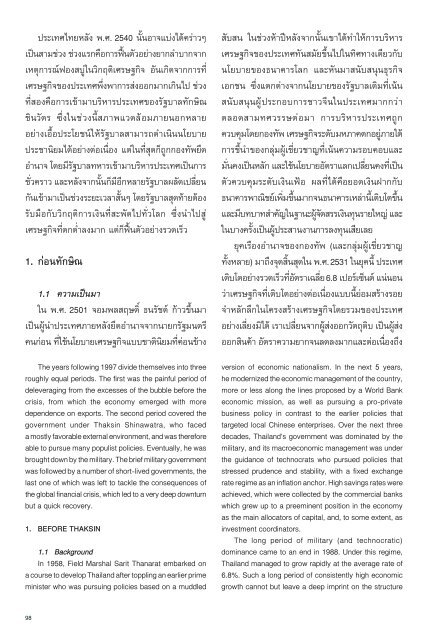บ้านเรือนถิ่นไทยในช่วงเจ็ดทศวรรษ 2489-2559
Create successful ePaper yourself
Turn your PDF publications into a flip-book with our unique Google optimized e-Paper software.
ประเทศไทยหลัง พ.ศ. 2540 นั้นอาจแบ่งได้คร่าวๆ<br />
เป็นสามช่วง ช่วงแรกคือการฟื้นตัวอย่างยากลำบากจาก<br />
เหตุการณ์ฟองสบู่ในวิกฤติเศรษฐกิจ อันเกิดจากการที่<br />
เศรษฐกิจของประเทศพึ่งพาการส่งออกมากเกินไป ช่วง<br />
ที่สองคือการเข้ามาบริหารประเทศของรัฐบาลทักษิณ<br />
ชินวัตร ซึ่งในช่วงนี้สภาพแวดล้อมภายนอกหลาย<br />
อย่างเอื้อประโยชน์ให้รัฐบาลสามารถดำเนินนโยบาย<br />
ประชานิยมได้อย่างต่อเนื่อง แต่ในที่สุดก็ถูกกองทัพยึด<br />
อำนาจ โดยมีรัฐบาลทหารเข้ามาบริหารประเทศเป็นการ<br />
ชั่วคราว และหลังจากนั้นก็มีอีกหลายรัฐบาลผลัดเปลี่ยน<br />
กันเข้ามาเป็นช่วงระยะเวลาสั้นๆ โดยรัฐบาลสุดท้ายต้อง<br />
รับมือกับวิกฤติการเงินที่สะพัดไปทั่วโลก ซึ่งนำไปสู่<br />
เศรษฐกิจที่ตกต่ำลงมาก แต่ก็ฟื้นตัวอย่างรวดเร็ว<br />
1. ก่อนทักษิณ<br />
1.1 ความเป็นมา<br />
ใน พ.ศ. 2501 จอมพลสฤษดิ์ ธนรัชต์ ก้าวขึ้นมา<br />
เป็นผู้นำประเทศภายหลังยึดอำนาจจากนายกรัฐมนตรี<br />
คนก่อน ที่ใช้นโยบายเศรษฐกิจแบบชาตินิยมที่ค่อนข้าง<br />
The years following 1997 divide themselves into three<br />
roughly equal periods. The first was the painful period of<br />
deleveraging from the excesses of the bubble before the<br />
crisis, from which the economy emerged with more<br />
dependence on exports. The second period covered the<br />
government under Thaksin Shinawatra, who faced<br />
a mostly favorable external environment, and was therefore<br />
able to pursue many populist policies. Eventually, he was<br />
brought down by the military. The brief military government<br />
was followed by a number of short-lived governments, the<br />
last one of which was left to tackle the consequences of<br />
the global financial crisis, which led to a very deep downturn<br />
but a quick recovery.<br />
1. BEFORE THAKSIN<br />
1.1 Background<br />
In 1958, Field Marshal Sarit Thanarat embarked on<br />
a course to develop Thailand after toppling an earlier prime<br />
minister who was pursuing policies based on a muddled<br />
สับสน ในช่วงห้าปีหลังจากนั้นเขาได้ทำให้การบริหาร<br />
เศรษฐกิจของประเทศทันสมัยขึ้นไปในทิศทางเดียวกับ<br />
นโยบายของธนาคารโลก และหันมาสนับสนุนธุรกิจ<br />
เอกชน ซึ่งแตกต่างจากนโยบายของรัฐบาลเดิมที่เน้น<br />
สนับสนุนผู้ประกอบการชาวจีนในประเทศมากกว่า<br />
ตลอดสามทศวรรษต่อมา การบริหารประเทศถูก<br />
ควบคุมโดยกองทัพ เศรษฐกิจระดับมหภาคตกอยู่ภายใต้<br />
การชี้นำของกลุ่มผู้เชี่ยวชาญที่เน้นความรอบคอบและ<br />
มั่นคงเป็นหลัก และใช้นโยบายอัตราแลกเปลี่ยนคงที่เป็น<br />
ตัวควบคุมระดับเงินเฟ้อ ผลที่ได้คือยอดเงินฝากกับ<br />
ธนาคารพาณิชย์เพิ่มขึ้นมากจนธนาคารเหล่านี้เติบโตขึ้น<br />
และมีบทบาทสำคัญในฐานะผู้จัดสรรเงินทุนรายใหญ่ และ<br />
ในบางครั้งเป็นผู้ประสานงานการลงทุนเสียเลย<br />
ยุคเรืองอำนาจของกองทัพ (และกลุ่มผู้เชี่ยวชาญ<br />
ทั้งหลาย) มาถึงจุดสิ้นสุดใน พ.ศ. 2531 ในยุคนี้ ประเทศ<br />
เติบโตอย่างรวดเร็วที่อัตราเฉลี่ย 6.8 เปอร์เซ็นต์ แน่นอน<br />
ว่าเศรษฐกิจที่เติบโตอย่างต่อเนื่องแบบนี้ย่อมสร้างรอย<br />
จำหลักลึกในโครงสร้างเศรษฐกิจโดยรวมของประเทศ<br />
อย่างเลี่ยงมิได้ เราเปลี่ยนจากผู้ส่งออกวัตถุดิบ เป็นผู้ส่ง<br />
ออกสินค้า อัตราความยากจนลดลงมากและต่อเนื่องถึง<br />
version of economic nationalism. In the next 5 years,<br />
he modernized the economic management of the country,<br />
more or less along the lines proposed by a World Bank<br />
economic mission, as well as pursuing a pro-private<br />
business policy in contrast to the earlier policies that<br />
targeted local Chinese enterprises. Over the next three<br />
decades, Thailand’s government was dominated by the<br />
military, and its macroeconomic management was under<br />
the guidance of technocrats who pursued policies that<br />
stressed prudence and stability, with a fixed exchange<br />
rate regime as an inflation anchor. High savings rates were<br />
achieved, which were collected by the commercial banks<br />
which grew up to a preeminent position in the economy<br />
as the main allocators of capital, and, to some extent, as<br />
investment coordinators.<br />
The long period of military (and technocratic)<br />
dominance came to an end in 1988. Under this regime,<br />
Thailand managed to grow rapidly at the average rate of<br />
6.8%. Such a long period of consistently high economic<br />
growth cannot but leave a deep imprint on the structure<br />
98


















